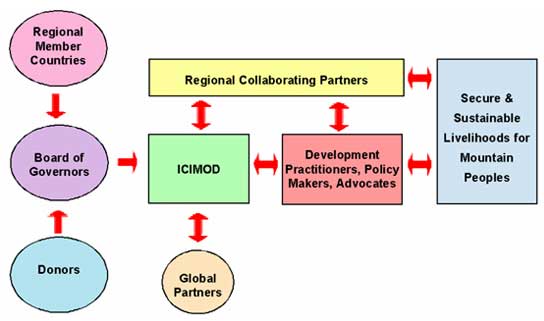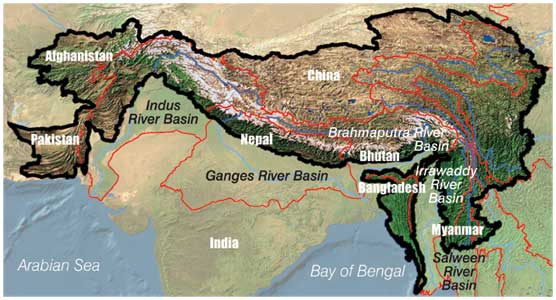简介
国际山地综合发展中心是一个为喜马拉雅山八个地区成员国和全球山地社区服务的、独立的国际山地研究和知识创新中心。1983年成立于尼泊尔加德满都的山地中心与地区成员国多个机构伙伴一起致力于喜马拉雅山地区前途保障的发展行动。
宗旨
建设和平、平等、环境可持续的繁荣富强和有保障的山地社区
使命
与地区和国际伙伴一起克服山地居民经济、社会和环境上的脆弱性的行动和变化而共同开发和提供综合和创新的途径。
ICIMOD——一个山地研究学习和知识中心
作为喜马拉雅地区应用性研究和发展的核心机构,山地中心的战略是与其合作伙伴一起为贫困和弱势群体寻找克服山地脆弱性和并转化为保障和可持续性而发现、试验、适应和交流的机会和途径。中心充分发挥有广泛合作伙伴的地区机构的优势,积极为寻求全球山区发展途径而提供服务的一个山地研究学习和知识中心,创造合作网络和良好环境,使其发展方案在不同规模的贫困和弱势人群中开花结果。
山地中心同时为亚太山地网络的秘书处和全球山地论坛的所在地。作为山地论坛的节点之一的亚太山地网络是个关注亚太山地和山区问题而分享信息、提高关注程度和寻找发展途径的机构和个人的论坛。山地论坛为平等和生态可持续的山区发展而推动全球行动
Who We Are:
The International Centre for Integrated Mountain Development (ICIMOD) is an international independent mountain learning and knowledge centre committed to improving the sustainable livelihoods of mountain peoples in the greater Himalayan region. ICIMOD serves eight regional member countries of the Hindu Kush-Himalayan area – Afghanistan, Bangladesh, Bhutan, China, India, Myanmar, Nepal, and Pakistan – and the global mountain community. Founded in 1983, ICIMOD is based in Kathmandu, Nepal, and brings together a partnership of its regional member countries, partner institutions, and donors with a commitment for development action to secure a better future for the people and environment of the extended Himalayan region.

Vision: Together with its partners and regional member countries, ICIMOD is committed to a shared vision of prosperous and secure mountain communities committed to peace, equity, and environmental sustainability.
Mission: ICIMOD’s mission is to develop and provide integrated and innovative solutions, in cooperation with national, regional, and international partners, which foster action and change for overcoming mountain people’s economic, social, and physical vulnerability.

As an applied research and development institution in the heart of the Himalayan region, ICIMOD's strategy is based on working with its partners to identify, test, adapt and communicateopportunities for overcoming mountain vulnerabilities andtransforming them into more security and sustainability for poor and marginalised mountain peoples. ICIMOD seeks to build on its comparative advantage, as a regionally mandated and grounded mountain-specific institution with a wide network of partners, to serve as a Mountain Learning and Knowledge Centrethat identifies and fosters solutions across the mountain world.ICIMOD works to build the cooperative networks and enabling environments through which these solutions can be implemented on a scale that will produce tangible results for the poor and marginalised of the region and beyond.
ICIMOD builds institutional capacities and facilitates the development of mountain policy and regional cooperation through its main functions as a:
· multidisciplinary documentation centre,
· focal point for problem solving by research,
· focal point for training, and
· consultative centre on the sustainable development of mountain natural, human and institutional resources.
The basic approach is summarised in the diagram below.

The idea of creating an institution to promote the ecologically sound development of mountainous regions was first discussed at the International Workshop on the Development of Mountain Environment in December 1974 in Munich, Germany, but it was only five years later in 1979 during a United Nations Educational, Scientific and Cultural Organisation (UNESCO) Regional Meeting in Kathmandu, under the framework of the Man and the Biosphere Programme, that concrete commitments were made to establish the Centre. The Government of Nepal offered to host the new institution, and the Governments of Switzerland and the Federal Republic of Germany and UNESCO agreed to act as the founding sponsors. His Majesty’s Government of Nepal and UNESCO signed the agreement that provided the legal basis for establishing the Centre in September 1981 in Paris. The Centre was finally established and inaugurated in December 1983 with its headquarters in Kathmandu, Nepal, and legitimised through an Act of Parliament in Nepal in the same year.
Website:HTTP://www.ICIMOD.org.
喜玛拉雅地区:
喜马拉雅山区养育着一亿五千万人,此外,它对于居住在下游平原河谷地区3倍于此人口数量的人们有着极大的影响。这里不仅仅是世界上最高的山区,还是最贫穷,人口最密集和环境最脆弱的地区。从西部的阿富汗到东部的孟加拉延绵3500公里,从北部中国西藏高原到南部印度的恒河盆地。亚洲8大主要河流均发源于此区域,印度河、恒河、雅鲁藏布江、伊洛瓦底江、怒江(萨尔温江)、澜沧江(眉公河)、长江和黄河。喜玛拉雅地区还以动、植物以及民族和语言的多样性而闻名。仅在中国的山区就有近55个民族,整个地区估计超过300个民族。然而,即便有如此丰富的资源,这个地区的人们仍处于极度贫穷、脆弱的社会和经济环境中。一些地区1年中有8个月处于饥饿与食物不足中。各种自然和社会的压力导致了冲突,在一些地区已演变为长期的暴力冲突。
过去,政策制定者们往往忽视山区,导致缺乏对影响山区人类和自然进程的了解,制定政策时没有考虑山区的具体情况。所制定发展计划只考虑到表面想象而没有深究其原因,致使错过了许多的发展机遇。实际上,山地可以为山区这一特定地区的消除贫困和可持续发展提供许多有利的契机。尽管受到一些限制,山区人民仍有巨大的发展潜能,定能走出贫困。ICIMOD的努力就是为改善喜玛拉雅地区人们的生活方式,特别是农牧民和基层及社区领导。山地中心最直接的受益者就是能够给山区发展作出贡献的政策和决策制定者、发展研究者和实践者以及基于社区的非政府机构。
The greater Himalayan region sustains approximately 150 million people and has major impacts on the lives of three times as many people living on the plains and in the river basins below. Not only the world’s highest mountain region, the Himalaya are the poorest and most complex. The region extends over 3,500 kilometres from Afghanistan in the west to Myanmar in the east, and ranges from the plateau regions of Tibet and other mountain areas of China in the north to the Ganges Basin of India in the south. The upland watersheds of Asia’s eight major river systems – the Indus, Ganges, Brahmaputra (Yarlungtsanpo), Irrawaddy, Salween (Nu), Mekong (Lancang), Yangtze (Jinsha), and Yellow River (Huanghe) – originate in these mountains. The wealth of the Himalaya also lies in an immense diversity of flora and fauna and ethnic groups and languages. There are approximately 55 different mountain ethnic groups in the mountains of China alone, and estimates for the whole region would exceed 300 groups. Yet, despite this rich diversity, the peoples of this vast mountain region are, in the majority, abysmally poor and vulnerable to environmental, social and economic forces. Some pockets experience eight months of hunger or food deficit in a year. A variety of pressures both natural and human have fueled conflict, and in several areas this conflict has erupted into on-going violence.

In the past, policy-makers neglected mountain areas, resulting in a general lack of understanding of the natural and human processes affecting these mountains and exclusion of mountain peoples from decision making. The development interventions that were designed were often extensions of plains’ solutions that narrowly addressed the symptoms rather than the causes, largely ignoring appropriate opportunities for development. However, the mountains provide a number of opportunities for mountain specific development and conservation that are increasingly providing a basis for reducing poverty and increasing sustainability. Despite the prevailing constraints in mountain areas there exists immense potential to promote a chain of development activities which can lead to the total well being of the people of these areas.
ICIMOD's efforts are all ultimately geared towards improved livelihoods of mountain peoples of the Himalayan region, particularly the farmers and grassroots-level development workers and community leaders. The Centre's immediate beneficiaries are those who function as agents of change to bring about widespread improvements, such as policy and decision-makers, development researchers and practitioners, and non-government and community based institutions

